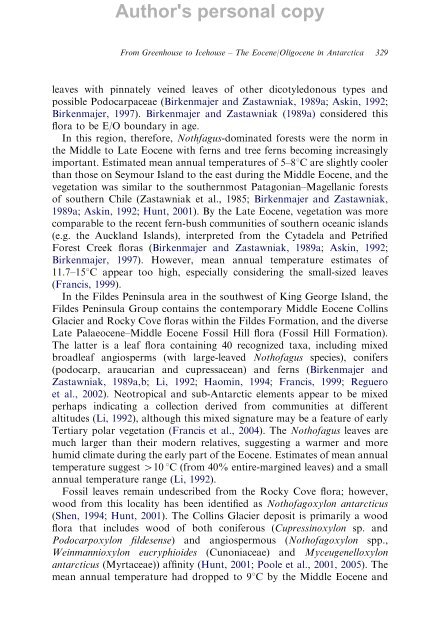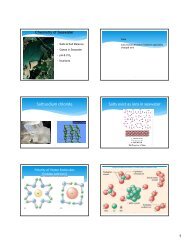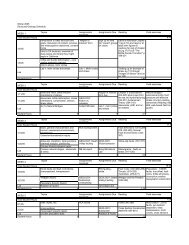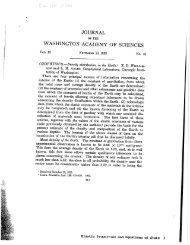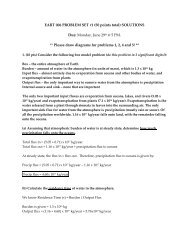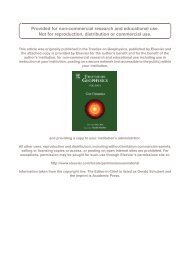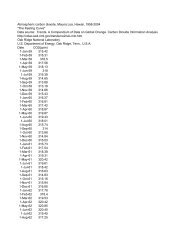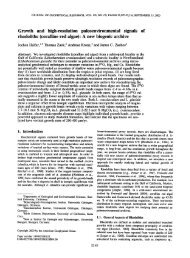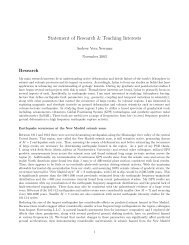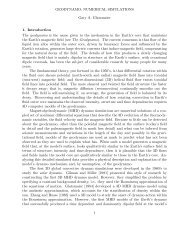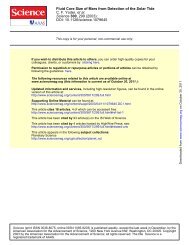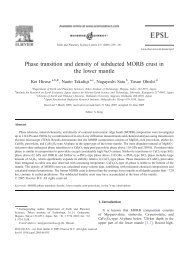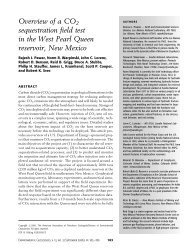From Greenhouse to Icehouse – The Eocene/Oligocene - UMass ...
From Greenhouse to Icehouse – The Eocene/Oligocene - UMass ...
From Greenhouse to Icehouse – The Eocene/Oligocene - UMass ...
You also want an ePaper? Increase the reach of your titles
YUMPU automatically turns print PDFs into web optimized ePapers that Google loves.
Author's personal copy<br />
<strong>From</strong> <strong>Greenhouse</strong> <strong>to</strong> <strong>Icehouse</strong> <strong>–</strong> <strong>The</strong> <strong>Eocene</strong>/<strong>Oligocene</strong> in Antarctica 329<br />
leaves with pinnately veined leaves of other dicotyledonous types and<br />
possible Podocarpaceae (Birkenmajer and Zastawniak, 1989a; Askin, 1992;<br />
Birkenmajer, 1997). Birkenmajer and Zastawniak (1989a) considered this<br />
flora <strong>to</strong> be E/O boundary in age.<br />
In this region, therefore, Nothfagus-dominated forests were the norm in<br />
the Middle <strong>to</strong> Late <strong>Eocene</strong> with ferns and tree ferns becoming increasingly<br />
important. Estimated mean annual temperatures of 5<strong>–</strong>81C are slightly cooler<br />
than those on Seymour Island <strong>to</strong> the east during the Middle <strong>Eocene</strong>, and the<br />
vegetation was similar <strong>to</strong> the southernmost Patagonian<strong>–</strong>Magellanic forests<br />
of southern Chile (Zastawniak et al., 1985; Birkenmajer and Zastawniak,<br />
1989a; Askin, 1992; Hunt, 2001). By the Late <strong>Eocene</strong>, vegetation was more<br />
comparable <strong>to</strong> the recent fern-bush communities of southern oceanic islands<br />
(e.g. the Auckland Islands), interpreted from the Cytadela and Petrified<br />
Forest Creek floras (Birkenmajer and Zastawniak, 1989a; Askin, 1992;<br />
Birkenmajer, 1997). However, mean annual temperature estimates of<br />
11.7<strong>–</strong>151C appear <strong>to</strong>o high, especially considering the small-sized leaves<br />
(Francis, 1999).<br />
In the Fildes Peninsula area in the southwest of King George Island, the<br />
Fildes Peninsula Group contains the contemporary Middle <strong>Eocene</strong> Collins<br />
Glacier and Rocky Cove floras within the Fildes Formation, and the diverse<br />
Late Palaeocene<strong>–</strong>Middle <strong>Eocene</strong> Fossil Hill flora (Fossil Hill Formation).<br />
<strong>The</strong> latter is a leaf flora containing 40 recognized taxa, including mixed<br />
broadleaf angiosperms (with large-leaved Nothofagus species), conifers<br />
(podocarp, araucarian and cupressacean) and ferns (Birkenmajer and<br />
Zastawniak, 1989a,b; Li, 1992; Haomin, 1994; Francis, 1999; Reguero<br />
et al., 2002). Neotropical and sub-Antarctic elements appear <strong>to</strong> be mixed<br />
perhaps indicating a collection derived from communities at different<br />
altitudes (Li, 1992), although this mixed signature may be a feature of early<br />
Tertiary polar vegetation (Francis et al., 2004). <strong>The</strong> Nothofagus leaves are<br />
much larger than their modern relatives, suggesting a warmer and more<br />
humid climate during the early part of the <strong>Eocene</strong>. Estimates of mean annual<br />
temperature suggest W10 1C (from 40% entire-margined leaves) and a small<br />
annual temperature range (Li, 1992).<br />
Fossil leaves remain undescribed from the Rocky Cove flora; however,<br />
wood from this locality has been identified as Nothofagoxylon antarcticus<br />
(Shen, 1994; Hunt, 2001). <strong>The</strong> Collins Glacier deposit is primarily a wood<br />
flora that includes wood of both coniferous (Cupressinoxylon sp. and<br />
Podocarpoxylon fildesense) and angiospermous (Nothofagoxylon spp.,<br />
Weinmannioxylon eucryphioides (Cunoniaceae) and Myceugenelloxylon<br />
antarcticus (Myrtaceae)) affinity (Hunt, 2001; Poole et al., 2001, 2005). <strong>The</strong><br />
mean annual temperature had dropped <strong>to</strong> 91C by the Middle <strong>Eocene</strong> and


